A Guide To Customer Journey In SaaS
Updated on June 21st, 2024
Customer loyalty stems from pleasant customer experiences. A loyal customer contributes to two crucial elements — long-term business and social proof.
However, every customer will experience doubts, roadblocks, and frustrations when considering a new brand. In particular, for B2B businesses, a customer’s journey is long and complex and involves multiple decision-makers. With the buying process taking place on a global stage, where you compete with rivals from around the world, standing out in a crowded market requires extra effort to acquire and retain customers.
To smoothen these creases and create a wholesome buying experience for buyers, every step must be carefully be catered to.
By mapping customer journey in SaaS, you understand the challenges your customers face at each stage of the purchase experience, identify areas of improvement and focus your resources on what’s important.
But building a customer journey map and tracking customer journeys efficiently is a complex process even professional marketers find hard to do perfectly. In this article, we have created a step-by-step guide for you.
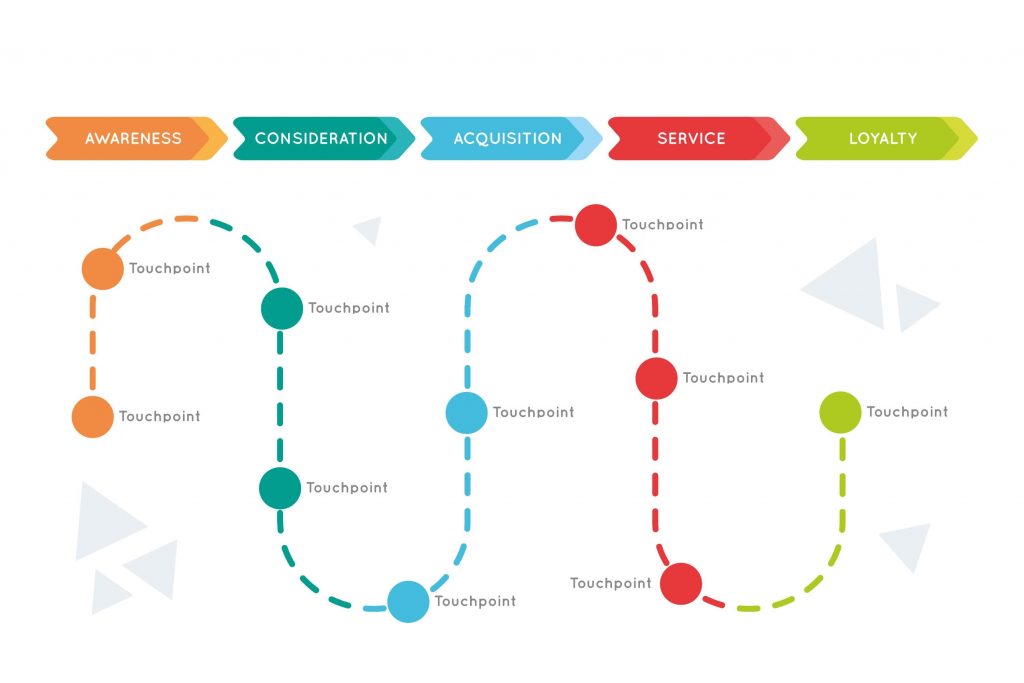
What is a Customer Journey in SaaS?
The SaaS customer journey is a visual representation of the buyer’s experience, encompassing all interactions between the consumer and the brand across channels and time. By developing this roadmap, companies can identify flaws in their current customer experience, gain insights into customer motivation and requirements, and enhance overall customer journeys.
They can compare every stage’s success with business goals and optimize them to give the best experience to the customers.
So, what are the key differences between the SaaS customer journey and other types of B2B customer journeys?
SaaS customer journeys are more predictable. The process is more linear than in other industries. Plus, engagement usually happens within your website and applications, giving you full control over tracking and analysis.
Unlike most other industries, self-service plays a critical role in the SaaS customer journey.
Most software services offer free trials, which isn’t the norm in other industries.
How Does Customer Journey Mapping for SaaS Work?
Customer journey mapping generates a visual representation of how your relationship with your customers develops across different touchpoints. The aim here is to understand customer pain points, identify unmet consumer needs, and enhance the customer journey holistically.
Prerequisites for SaaS customer journey mapping
Before mapping the customer journey for your SaaS brand, here are some things you need to prepare first:
1. Set goals
Every process gets the best results when the specific goals are clear from the start. Understand what you want to achieve with your customer journey map. This will help you set up an appropriate budget and remain target-oriented with your resources. Possible SaaS customer journey goals may include enhancing the onboarding process, increasing customer retention, and streamlining product adoption.
For example, if your goal is to increase subscribers for a particular package, you can nurture targeted leads better with that package-specific data.
2. Create a buyer persona
The next step is to segment your target audience and define the ideal customer persona for each. By creating a distinct user profile, you can personalize customer journeys better and increase the conversion rate across segments.
3. Define customer touchpoints
Identify every crucial point of contact between your product, your company, and the end user. This will help you define the unique problems of each touchpoint and solve them efficiently.
Benefits of Customer Journey Mapping
Understanding customers
Customers don’t always think or act according to your expectations. As a service provider, you collect real-life insights by digging deep into the interactions and understanding where your consumers are struggling in their journey. This way, you can make a customer-centric SaaS brand, increasing your conversion and retention rate.
Identify user needs
Mapping customer journeys helps you see the gaps in customer experience. You map out how customers interact on your website and app, identify roadblocks, and fix them to enhance customer experience.
For example, if you see visitors dropping out without completing the onboarding process, you can include tutorial videos or helpful pop-ups to help them navigate better.
Visualizing emotions
With a methodically mapped customer journey, you can quantify how your customers are feeling or what they are thinking while interacting with your services. By acting on these insights, you win your consumer’s trust and develop brand loyalty.
Improving cost-effectiveness
Marketing and customer acquisition are expensive. By mapping customer journeys accurately, you can enhance your product’s features, improve UX on your website, and personalize the customer experience.
You can also get rid of technical issues, increasing customer satisfaction and building loyalty to your SaaS brand.
Getting a competitive edge
Tracking customer journeys reveals what you need to improve to make your product stand out. By identifying and closely monitoring customer patterns and requirements, you can understand what customers actually want and gain a competitive edge.
Retrieving crucial customer insights help you adapt to the ever-changing needs and stay relevant. The agility gives you a competitive edge in an overcrowded market.
Stages in the SaaS Customer Journey
Let’s look into the five stages of a SaaS customer journey:
Awareness
In this stage, your target market becomes aware of your services through marketing campaigns, search results, word of mouth, etc. For our example, a potential customer can find Salespanel from Google Search.
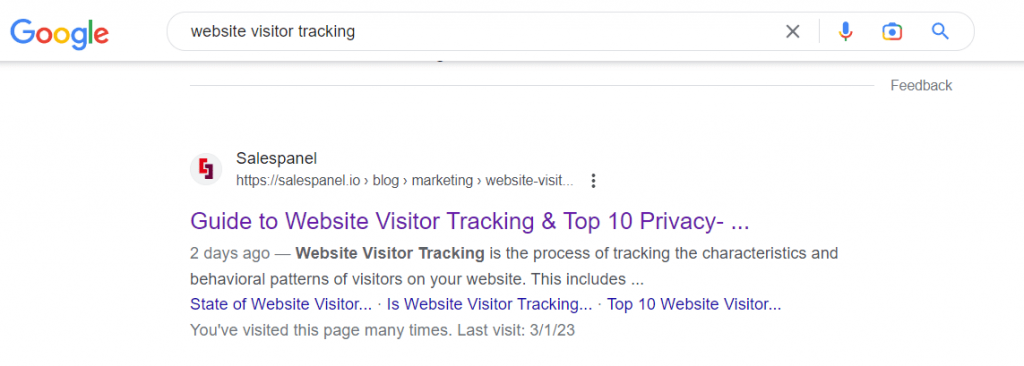
Evaluation
Once your product is discovered, your customers go through reviews, look into alternatives, and evaluate whether your services are worth investing in.
Your audience typically takes the help of search engines and goes through reviews and conversations on social media to evaluate the brand. He/she/they will also review pages from your website to learn more about you.
Once they are satisfied, they would sign up for a free trial or book a demo. This is standard for SaaS products.
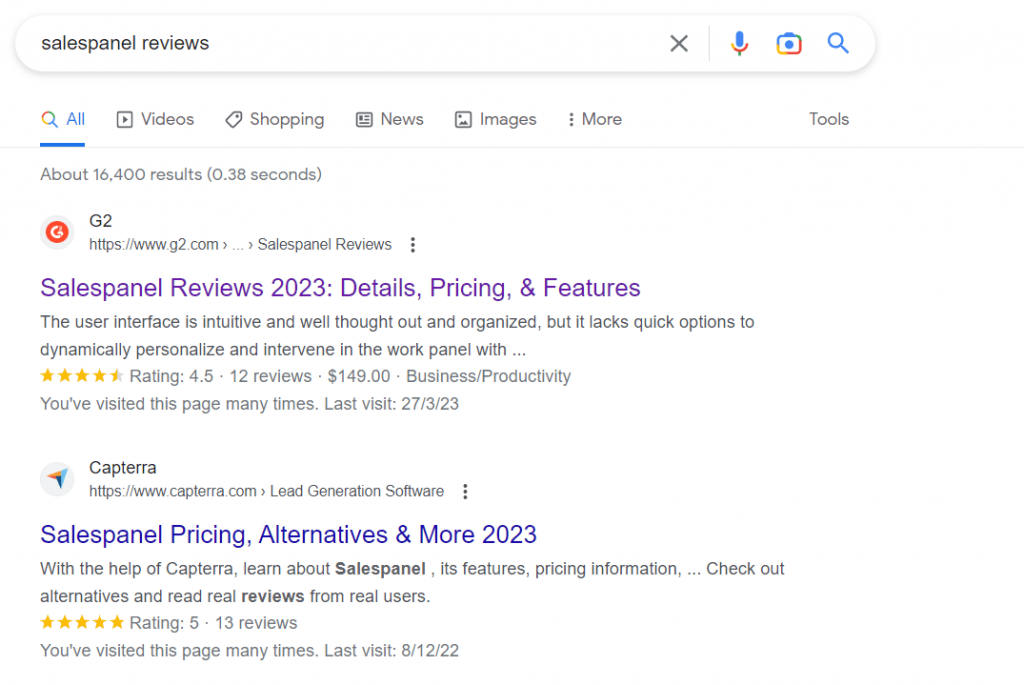
Conversion
In this stage, the customer adopts your product by making a purchase. For self-service SaaS products, this typically happens when the trial runs out but the customer continues to use the product. For Enterprise SaaS, communication is more direct.
Retention
Your product solves customer pain points and provides good support. So, they develop loyalty for your brand and continue to use the product. Some of your customers will churn but the rest should stay subscribed to your product for months or even years.
Expansion
Expansion is a critical stage for SaaS customer journeys, as there’s a huge opportunity of upselling and cross-selling to existing customers who use your product frequently. With proper strategies in place, your customers can be encouraged to upgrade their plans, purchase additional features, or add more users to their accounts.
Advocacy
The retained customers endorse your product and amplify your brand’s visibility. The results depend on how well you handle the previous four stages. Your customers might talk about you, and refer you to their peers or people in their network. You can also incentivize this.
Here’s how Trello did it:
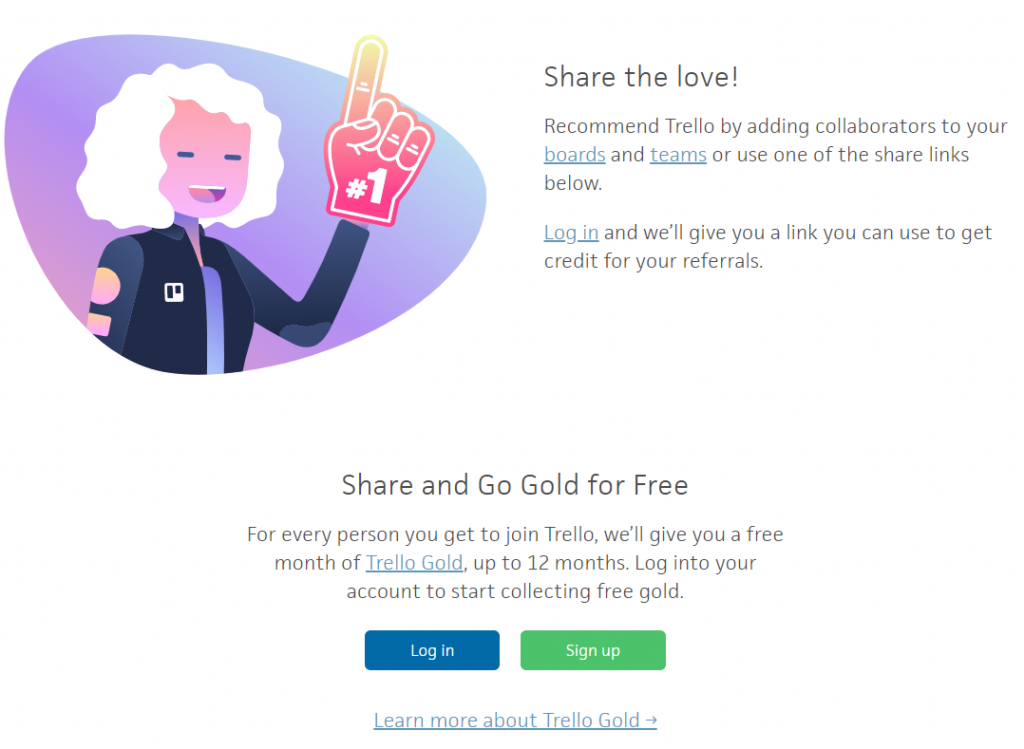
How Do You Track Customer Journeys for SaaS Products?
Define customer touchpoints
Identify every crucial point of contact between your product, your company, and the end user. This helps you define the unique problems of each touchpoint and solve them efficiently.
The most important SaaS customer journey touchpoints include:
- Website page visits
- Social media posts
- Sign up form on the homepage
- CTA on the landing page
- Product usage
For the most conclusive results, evaluate the pre and post-purchase touchpoints.
Monitor important KPIs
Quantifying customer interaction demands accurate and constant monitoring of customer journey KPIs. These include:
- Customer satisfaction score
- Customer effort score
- Bounce rate
- Social media impressions
- Conversion rate
- Clicks
- Time on page
- Click-through rate
- Cost-per-click
Compare KPIs with historical data
Once you measure all the above KPIs, compare them with your historical data. Benchmark them against your goal. If you don’t see any improvements or deterioration over time, identify the roadblocks and make necessary changes.
How Does Customer Journey Analytics and The Acquired Data Help?
Customer journey analytics is the data-driven process of analyzing the interactions a customer has with your company that impact your business. The generated results are presented via flow charts, graphs, and other visual documents.
Customer analytics analyzes the following points:
- Customer needs
- Emotional difficulties
- Survey results
- Key metrics of every step
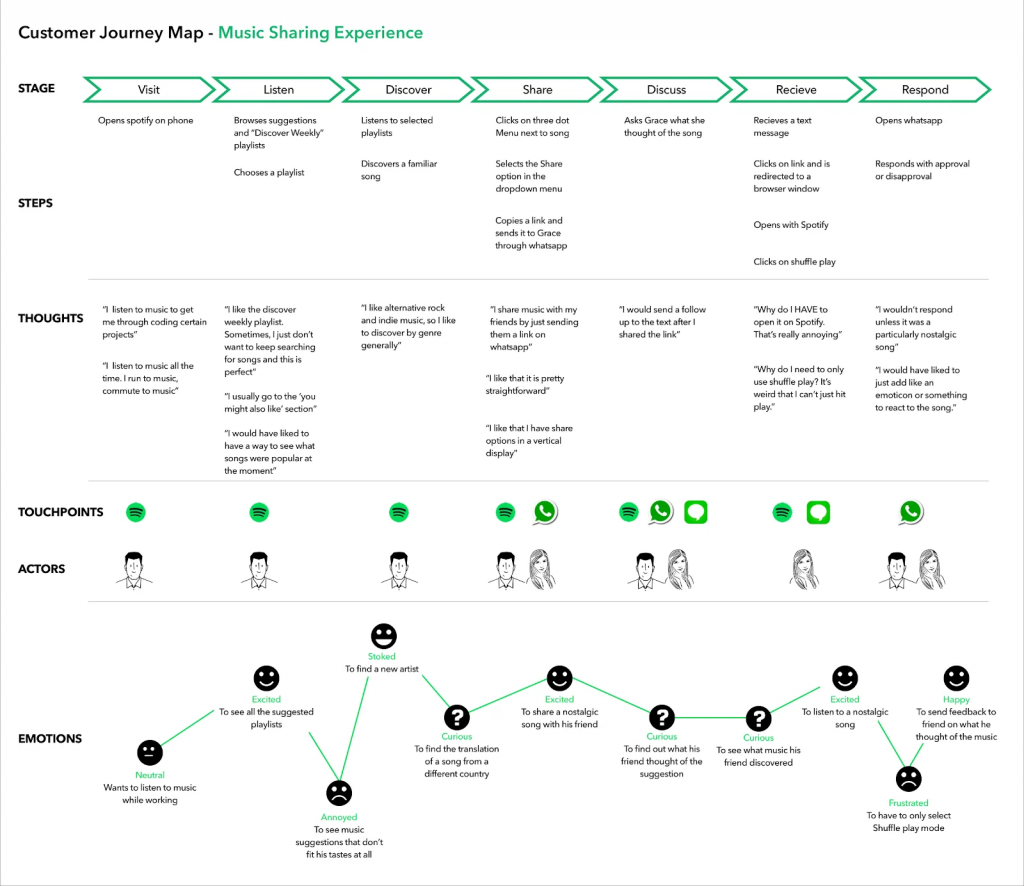
Image Source: Meghana Bowen
For example, Spotify’s customer journey map shows how each touchpoint, emotion, and interaction impacted the response. On every step, Spotify visually represents what a consumer is doing, feeling, and engaging with.
For conclusive insights, SaaS customer journey analytics needs to be accurate, regular, and real-time.
Personalization and Lead Prioritization Based on Customer Journey Data
The secret to a stellar user experience depends on how well you personalize the SaaS customer journey. You need to align your product, support, and marketing to accommodate the customer’s needs and expectations.
Tracking the customer journey helps you identify their requirements and personalize their experience for them. For example, if a customer is focused on a specific usecase, you can tailor your marketing and onboarding by sharing relevant content.
Salespanel can help you do this. With our product, you can track customer journeys across multiple channels and shows them in Single Customer View (SCV).
With Salespanel, aggregated customer journeys are not limited to analytics. The product helps you map customer journeys to individual B2B SaaS accounts. You can track every customer milestone and touchpoint with accuracy and efficiency. You can also understand how customers engage with your product throughout their journey.
Key Takeaways
1. Loyal customers are crucial for long-term business success and provide valuable social proof, enhancing brand credibility and attracting new customers.
2. The B2B customer journey is long and involves multiple decision-makers, requiring a strategic approach to stand out in a crowded global market.
3. Due to the complex nature of customer journeys, you are required to use specialized tools to gather data on interactions and identify areas for personalization and lead prioritization, improving customer engagement and satisfaction. Tools like Salespanel can help.
4. The journey includes these stages: Awareness, Evaluation, Conversion, Retention, Expansion, and Advocacy. Each stage requires specific strategies to guide customers smoothly from one phase to the next.
5. Mapping the customer journey helps identify customer challenges and areas for improvement, and put resources on critical touchpoints to enhance the overall buying experience.
Conclusion
Regardless of the market size and niche, every business can benefit by mapping the customer journey. However, for SaaS brands who have the advantage of the whole customer journey happen within their website, this is an absolute must.
For a software solution, having a poor user experience is damaging. A well-mapped customer journey can generate insights and help your brand better serve customers and identify those who are qualified for higher ticket plans.
Sell more, understand your customers’ journey for free!
Sales and Marketing teams spend millions of dollars to bring visitors to your website. But do you track your customer’s journey? Do you know who buys and why?
Around 8% of your website traffic will sign up on your lead forms. What happens to the other 92% of your traffic? Can you identify your visiting accounts? Can you engage and retarget your qualified visitors even if they are not identified?


